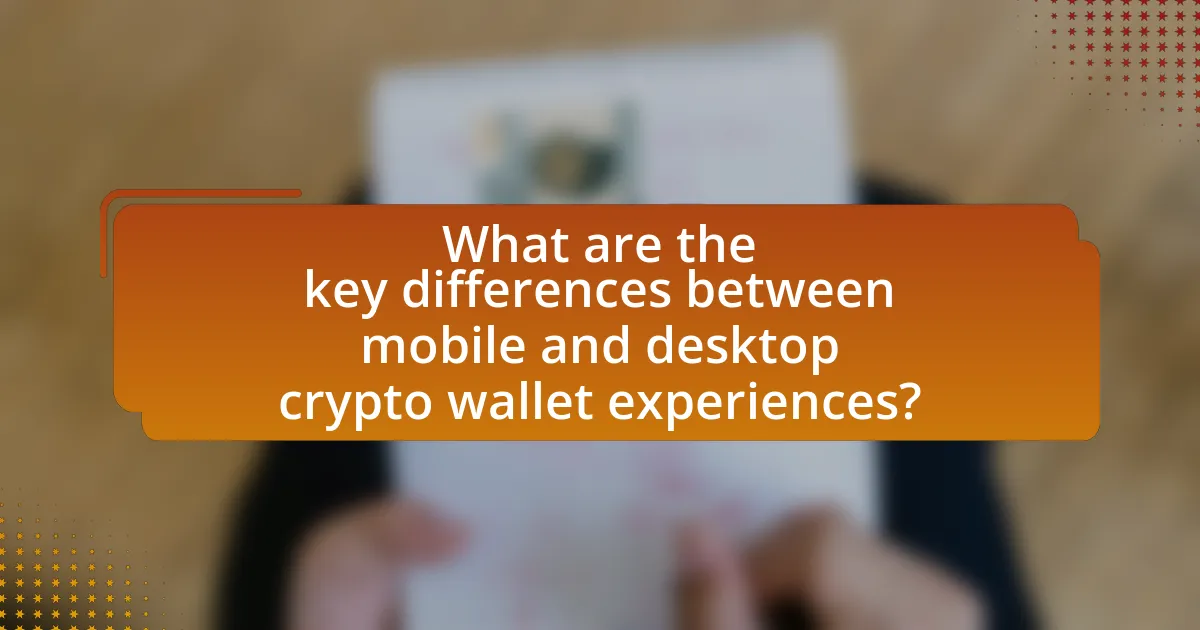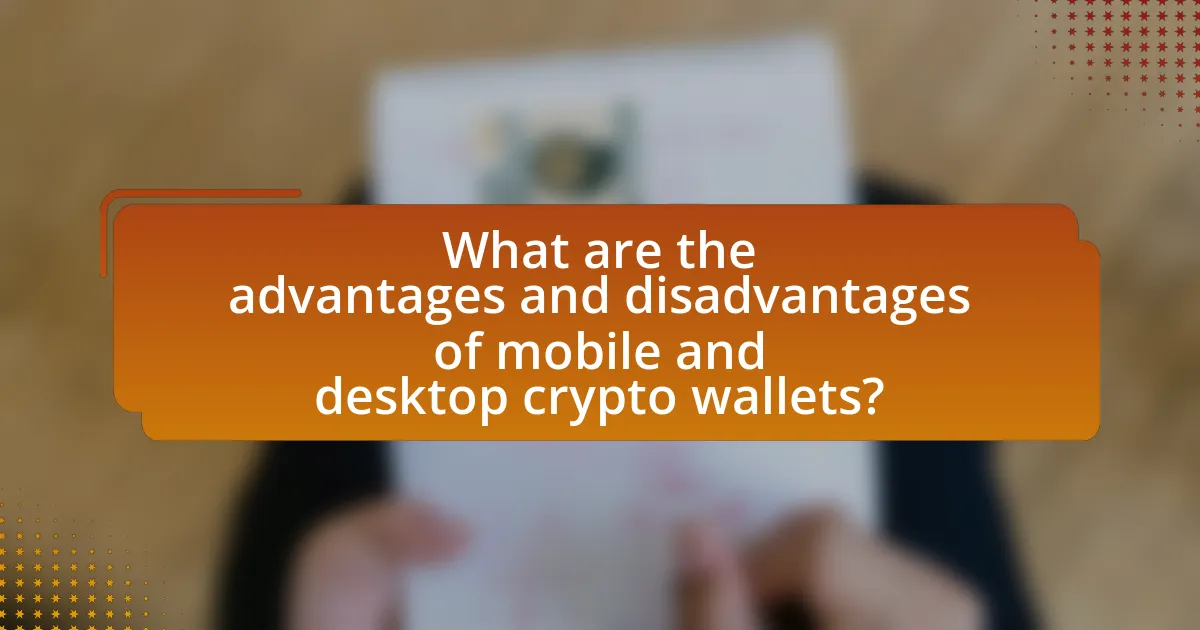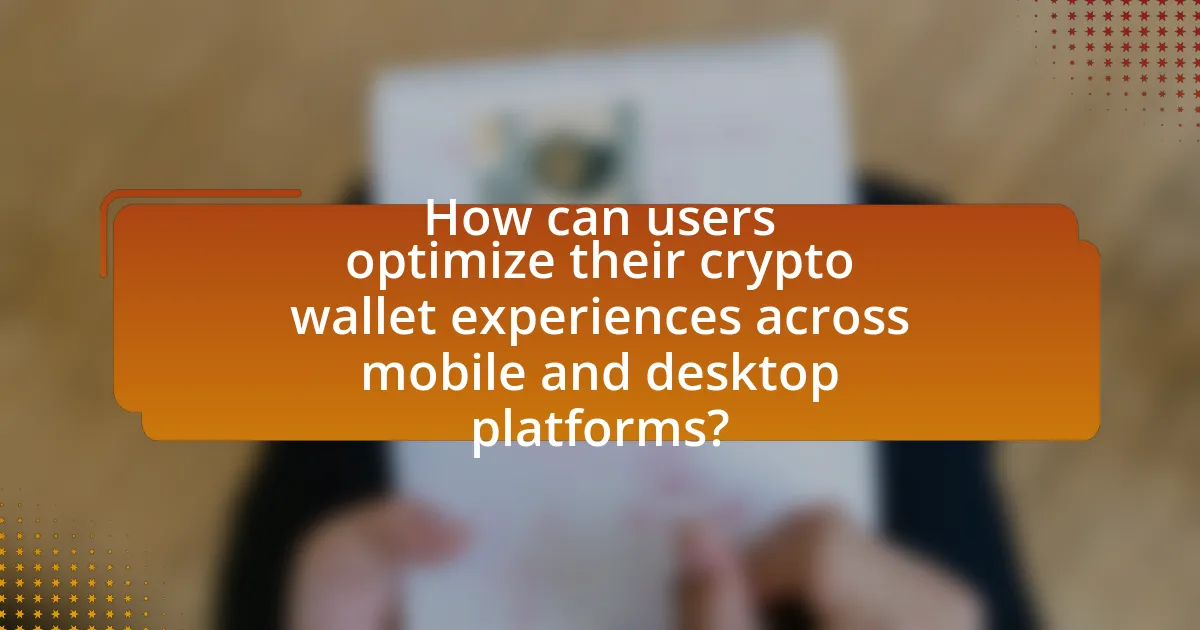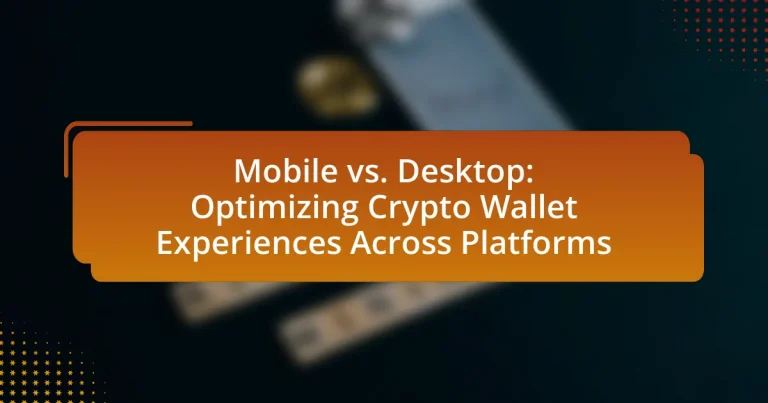The article focuses on the key differences between mobile and desktop crypto wallet experiences, highlighting aspects such as convenience, security, user interface design, and transaction speeds. Mobile wallets are characterized by their accessibility and user-friendly features, making them suitable for everyday transactions, while desktop wallets offer enhanced security and advanced functionalities for more experienced users. The discussion includes the impact of screen size on user interaction, security implications for each platform, and best practices for optimizing wallet experiences across devices. Additionally, it addresses the unique features of mobile wallets, the limitations of desktop wallets, and strategies for maintaining consistent transaction histories and usability across platforms.

What are the key differences between mobile and desktop crypto wallet experiences?
Mobile crypto wallets offer convenience and accessibility, allowing users to manage their assets on-the-go through smartphones, while desktop crypto wallets provide a more robust interface with enhanced security features and larger screen real estate for detailed management. Mobile wallets typically prioritize user-friendly designs and quick transactions, making them ideal for everyday use, whereas desktop wallets often include advanced functionalities such as multi-signature support and integration with trading platforms, catering to more experienced users. The differences are further highlighted by security; mobile wallets may be more vulnerable to theft due to device loss or malware, while desktop wallets can utilize hardware security modules for better protection.
How do user interfaces differ between mobile and desktop crypto wallets?
User interfaces for mobile and desktop crypto wallets differ primarily in design and functionality due to the distinct characteristics of each platform. Mobile wallets prioritize simplicity and touch-based navigation, featuring larger buttons and streamlined layouts to accommodate smaller screens, while desktop wallets offer more complex interfaces with detailed information and multiple functionalities visible simultaneously, leveraging the larger display area. For instance, mobile wallets often include quick access features like QR code scanning for transactions, whereas desktop wallets may provide advanced options such as multi-account management and extensive transaction history in a single view. This design approach reflects the need for quick, on-the-go transactions in mobile environments compared to the more comprehensive management capabilities suited for desktop use.
What design elements are crucial for mobile crypto wallets?
Crucial design elements for mobile crypto wallets include user-friendly interfaces, strong security features, and responsive layouts. User-friendly interfaces ensure that users can easily navigate the wallet, facilitating quick transactions and access to essential features. Strong security features, such as biometric authentication and encryption, protect users’ assets from unauthorized access, which is vital given the high value of cryptocurrencies. Responsive layouts adapt to various screen sizes, enhancing usability across different mobile devices. These elements collectively contribute to a seamless and secure user experience, which is essential for the adoption and trust in mobile crypto wallets.
How does screen size impact user interaction on desktop wallets?
Screen size significantly impacts user interaction on desktop wallets by influencing the layout, accessibility, and overall user experience. Larger screens allow for more information to be displayed simultaneously, enabling users to view multiple wallet features, transaction histories, and market data without excessive scrolling or navigation. This enhances usability, as users can make informed decisions quickly. Conversely, smaller screens may lead to a cluttered interface, requiring users to navigate through various menus, which can increase the time taken to complete transactions and potentially lead to errors. Research indicates that optimal screen size can improve user satisfaction and efficiency, as users are more likely to engage with a wallet that presents information clearly and concisely.
What are the security implications of using mobile versus desktop wallets?
Mobile wallets generally present higher security risks compared to desktop wallets due to their vulnerability to malware and phishing attacks. Mobile devices are often less secure because they can be easily lost or stolen, and they frequently connect to unsecured public Wi-Fi networks, increasing exposure to potential threats. In contrast, desktop wallets typically offer more robust security features, such as hardware wallet integration and the ability to use antivirus software, which can mitigate risks. According to a report by the Cybersecurity and Infrastructure Security Agency, mobile devices are targeted in 85% of mobile malware attacks, highlighting the significant security implications associated with mobile wallets.
How do mobile wallets protect user data differently than desktop wallets?
Mobile wallets protect user data differently than desktop wallets primarily through enhanced security features tailored for mobile environments. Mobile wallets often utilize biometric authentication methods, such as fingerprint or facial recognition, which provide an additional layer of security that desktop wallets typically do not offer. Furthermore, mobile wallets frequently employ end-to-end encryption and secure elements within the device to safeguard sensitive information, while desktop wallets may rely more on software-based security measures that can be more vulnerable to malware attacks. According to a report by the International Journal of Information Security, mobile devices are equipped with hardware security modules that can store cryptographic keys securely, making them less susceptible to unauthorized access compared to traditional desktop systems.
What common vulnerabilities exist for each platform?
Common vulnerabilities for mobile platforms include insecure data storage, insufficient encryption, and susceptibility to malware. Mobile devices often store sensitive information without adequate protection, making them targets for attackers. For desktop platforms, common vulnerabilities include outdated software, lack of security patches, and phishing attacks. Desktop systems can be compromised through unpatched vulnerabilities, allowing unauthorized access to sensitive data. Both platforms face risks from social engineering tactics, which exploit user behavior to gain access to systems.
How do transaction speeds compare between mobile and desktop wallets?
Transaction speeds between mobile and desktop wallets are generally comparable, with both platforms capable of processing transactions quickly depending on network conditions. However, mobile wallets may experience slightly slower speeds due to factors such as varying internet connectivity and device performance. For instance, a study by the Cambridge Centre for Alternative Finance indicates that mobile wallets can be affected by the user’s mobile data speed, while desktop wallets typically benefit from more stable internet connections.
What factors influence transaction processing times on mobile devices?
Transaction processing times on mobile devices are influenced by network connectivity, device performance, and application design. Network connectivity affects the speed of data transmission; for instance, a stable 4G or 5G connection typically results in faster processing compared to slower Wi-Fi or 3G connections. Device performance, including CPU speed and memory capacity, directly impacts how quickly a mobile device can execute transaction-related tasks. Additionally, application design plays a crucial role; well-optimized apps can reduce processing times by minimizing resource usage and streamlining user interactions. Studies have shown that mobile applications with efficient coding and user interface design can enhance transaction speeds significantly, demonstrating the importance of these factors in the overall user experience.
How does network connectivity affect desktop wallet performance?
Network connectivity significantly impacts desktop wallet performance by determining the speed and reliability of transactions. A stable and high-speed internet connection allows for quicker synchronization with the blockchain, enabling faster transaction confirmations and updates. Conversely, poor connectivity can lead to delays, increased transaction times, and potential failures in sending or receiving cryptocurrency. For instance, a study by the Cambridge Centre for Alternative Finance highlights that latency in network connections can directly affect user experience, causing frustration and inefficiencies in wallet operations.

What are the advantages and disadvantages of mobile and desktop crypto wallets?
Mobile crypto wallets offer convenience and accessibility, allowing users to manage their cryptocurrencies on-the-go through smartphones. They typically provide features like QR code scanning for transactions and instant notifications. However, mobile wallets are more susceptible to security risks such as malware and theft due to the vulnerabilities of mobile devices.
Desktop crypto wallets, on the other hand, provide enhanced security and control over private keys, as they are stored locally on a computer. This makes them less vulnerable to hacking compared to mobile wallets. However, desktop wallets lack the convenience of mobile wallets, requiring users to be at their computers to access their funds, which can be a disadvantage for those who need quick access.
In summary, mobile wallets excel in convenience but face security challenges, while desktop wallets offer better security but sacrifice accessibility.
What benefits do mobile wallets offer to users?
Mobile wallets offer users convenience, security, and enhanced transaction speed. Users can store multiple payment methods in one place, making transactions quick and easy, often with just a tap or scan. Security features such as biometric authentication and encryption protect sensitive information, reducing the risk of fraud. Additionally, mobile wallets facilitate instant transactions, allowing users to send and receive funds in real-time, which is particularly beneficial in the fast-paced world of cryptocurrency. According to a report by Statista, the global mobile wallet market is projected to reach $7.58 trillion by 2027, highlighting the growing adoption and trust in mobile wallet technology.
How does portability enhance the user experience with mobile wallets?
Portability significantly enhances the user experience with mobile wallets by allowing users to access their funds and make transactions anytime and anywhere. This convenience eliminates the need for physical cash or cards, enabling quick payments and transfers directly from a mobile device. According to a study by Statista, as of 2023, over 80% of smartphone users have utilized mobile payment services, highlighting the demand for accessible financial solutions. The ability to conduct transactions on-the-go fosters a seamless and efficient financial management experience, making mobile wallets an essential tool for modern users.
What features make mobile wallets more accessible for everyday transactions?
Mobile wallets are made more accessible for everyday transactions through features such as user-friendly interfaces, instant payment capabilities, and integration with various payment methods. User-friendly interfaces simplify navigation and transaction processes, allowing users to complete payments quickly. Instant payment capabilities enable real-time transactions, which are crucial for everyday purchases. Additionally, integration with multiple payment methods, including credit cards, bank accounts, and cryptocurrencies, enhances flexibility and convenience for users. These features collectively contribute to a seamless and efficient transaction experience, making mobile wallets a practical choice for daily financial activities.
What limitations do desktop wallets present to users?
Desktop wallets present several limitations to users, primarily related to security, accessibility, and user experience. Security risks arise from the fact that desktop wallets are often targeted by malware and hacking attempts, making them vulnerable if the user’s computer is compromised. Accessibility is another limitation, as desktop wallets require a specific device, restricting users from accessing their funds on-the-go, unlike mobile wallets that offer greater flexibility. Additionally, the user experience can be less intuitive compared to mobile applications, which are designed for ease of use and quick transactions. These factors collectively hinder the overall effectiveness of desktop wallets in providing a seamless cryptocurrency management experience.
How does the lack of mobility affect user engagement with desktop wallets?
The lack of mobility significantly reduces user engagement with desktop wallets. Users often prefer mobile wallets for their convenience and accessibility, allowing them to manage their cryptocurrencies on-the-go. According to a survey by Statista, 60% of cryptocurrency users prefer mobile applications for transactions due to the ease of access, which highlights the importance of mobility in user engagement. Consequently, desktop wallets, which are stationary and less convenient, may experience lower usage rates and engagement levels compared to their mobile counterparts.
What are the potential drawbacks of using desktop wallets for crypto management?
Desktop wallets for crypto management can be vulnerable to malware and hacking, which can lead to the loss of funds. Unlike hardware wallets, desktop wallets are connected to the internet, making them susceptible to cyber attacks. A study by Cybersecurity Ventures predicts that cybercrime will cost the world $10.5 trillion annually by 2025, highlighting the increasing risks associated with online financial management. Additionally, desktop wallets require regular software updates to maintain security, and failure to do so can expose users to vulnerabilities. Furthermore, if a user’s computer is compromised or experiences hardware failure, access to the crypto assets may be lost permanently.
What unique features do mobile wallets provide that desktop wallets may lack?
Mobile wallets offer unique features such as location-based services, QR code scanning, and push notifications that desktop wallets typically lack. Location-based services enable users to make transactions or access promotions based on their geographical location, enhancing convenience and usability. QR code scanning allows for quick and easy payments by simply scanning a code, streamlining the transaction process. Additionally, push notifications keep users informed about transaction updates, security alerts, and promotional offers in real-time, which is not a standard feature in desktop wallets. These functionalities cater to the on-the-go lifestyle of mobile users, making mobile wallets more adaptable to everyday transactions.
How do mobile wallets integrate with other applications and services?
Mobile wallets integrate with other applications and services through APIs (Application Programming Interfaces) that allow seamless data exchange and functionality sharing. These APIs enable mobile wallets to connect with payment gateways, e-commerce platforms, and financial services, facilitating transactions, account management, and user authentication. For instance, mobile wallets like Apple Pay and Google Pay utilize APIs to enable in-app purchases and contactless payments at retail locations, enhancing user convenience and security. Additionally, integration with loyalty programs and rewards systems allows users to earn points or discounts directly through their mobile wallets, further driving engagement and usage.
What innovative technologies are being utilized in mobile wallet development?
Innovative technologies utilized in mobile wallet development include Near Field Communication (NFC), biometric authentication, and blockchain technology. NFC enables contactless payments, allowing users to make transactions simply by tapping their devices. Biometric authentication, such as fingerprint and facial recognition, enhances security by ensuring that only authorized users can access the wallet. Blockchain technology underpins many mobile wallets, providing a decentralized and secure method for transaction verification and record-keeping. These technologies collectively improve user experience, security, and transaction efficiency in mobile wallets.

How can users optimize their crypto wallet experiences across mobile and desktop platforms?
Users can optimize their crypto wallet experiences across mobile and desktop platforms by ensuring they use wallets that offer seamless synchronization and robust security features. Selecting wallets that support cross-platform functionality allows users to access their funds and transaction history consistently, regardless of the device. Additionally, enabling two-factor authentication and using strong, unique passwords enhances security, protecting against unauthorized access. Research indicates that wallets with user-friendly interfaces and responsive customer support improve user satisfaction and efficiency in managing crypto assets.
What best practices should users follow for securing their crypto wallets?
To secure their crypto wallets, users should implement strong passwords, enable two-factor authentication (2FA), and regularly update wallet software. Strong passwords, consisting of a mix of letters, numbers, and symbols, significantly reduce the risk of unauthorized access. Enabling 2FA adds an additional layer of security by requiring a second form of verification, such as a text message or authentication app, before granting access. Regularly updating wallet software ensures that users benefit from the latest security patches and features, protecting against vulnerabilities. According to a report by the Cybersecurity & Infrastructure Security Agency, using these practices can reduce the likelihood of successful cyberattacks on digital wallets.
How can users enhance security settings on mobile wallets?
Users can enhance security settings on mobile wallets by enabling two-factor authentication (2FA), which adds an extra layer of protection beyond just a password. Implementing 2FA significantly reduces the risk of unauthorized access, as it requires a second form of verification, such as a code sent to the user’s phone. Additionally, users should regularly update their wallet apps to ensure they have the latest security patches, as outdated software can be vulnerable to attacks. Using strong, unique passwords for wallet accounts further strengthens security, as weak or reused passwords are easily compromised. Furthermore, users should consider biometric authentication options, such as fingerprint or facial recognition, which provide a secure and convenient way to access their wallets. According to a report by the Cybersecurity & Infrastructure Security Agency, enabling 2FA can prevent 99.9% of automated attacks, highlighting its effectiveness in enhancing security.
What measures can be taken to protect desktop wallets from threats?
To protect desktop wallets from threats, users should implement strong security measures such as using antivirus software, enabling firewalls, and keeping the operating system and wallet software updated. Antivirus software helps detect and eliminate malware that could compromise wallet security, while firewalls block unauthorized access to the system. Regular updates patch vulnerabilities that could be exploited by attackers. Additionally, users should utilize strong, unique passwords and consider enabling two-factor authentication for an added layer of security. These practices significantly reduce the risk of unauthorized access and theft of cryptocurrency assets.
How can users ensure a seamless experience when switching between mobile and desktop wallets?
Users can ensure a seamless experience when switching between mobile and desktop wallets by utilizing wallets that support cross-platform synchronization. This feature allows users to access the same wallet across devices, maintaining consistent balances and transaction histories. For instance, wallets like Exodus and Atomic Wallet offer this capability, enabling users to switch without losing data or functionality. Additionally, users should ensure that they are logged into the same account on both devices and that they have enabled any necessary security features, such as two-factor authentication, to protect their assets during the transition.
What synchronization options are available for managing wallets across devices?
Synchronization options for managing wallets across devices include cloud synchronization, local network synchronization, and manual backup and restore methods. Cloud synchronization allows users to access their wallets from multiple devices by storing wallet data on a secure server, ensuring real-time updates and accessibility. Local network synchronization enables devices connected to the same network to share wallet information directly, providing a faster and more secure option. Manual backup and restore methods involve exporting wallet data to a file and importing it on another device, offering a reliable way to transfer wallet information without relying on internet connectivity. These methods ensure that users can effectively manage their wallets across different platforms while maintaining security and accessibility.
How can users maintain consistent transaction histories between platforms?
Users can maintain consistent transaction histories between platforms by utilizing cross-platform wallet solutions that sync data in real-time. These wallets often employ cloud storage to ensure that transaction records are updated across devices, allowing users to access the same history whether they are on mobile or desktop. For example, wallets like Exodus and Trust Wallet provide seamless synchronization, ensuring that any transaction made on one device is reflected on another almost instantly. This capability is crucial for users who frequently switch between devices, as it minimizes discrepancies and enhances the overall user experience in managing cryptocurrency transactions.
What tips can improve the overall usability of crypto wallets on both platforms?
To improve the overall usability of crypto wallets on both mobile and desktop platforms, developers should prioritize user-friendly interfaces and seamless navigation. Simplifying the design enhances accessibility, allowing users to easily locate essential features such as sending, receiving, and managing assets. Additionally, implementing robust security measures, like two-factor authentication and biometric login, builds user trust and encourages engagement. Regular updates and user feedback integration can further refine the experience, ensuring that wallets remain intuitive and responsive to user needs. Research indicates that user-centric design significantly increases satisfaction and retention rates in digital applications, underscoring the importance of these strategies in enhancing usability.
How can users customize their wallet interfaces for better navigation?
Users can customize their wallet interfaces for better navigation by adjusting layout options, selecting preferred themes, and organizing features according to personal usage patterns. Many wallet applications offer settings that allow users to rearrange icons, prioritize frequently used functions, and choose between light or dark modes, enhancing visibility and accessibility. Research indicates that user-centric design significantly improves navigation efficiency, as evidenced by studies showing that personalized interfaces can reduce task completion time by up to 30%.
What resources are available for troubleshooting common wallet issues?
Resources available for troubleshooting common wallet issues include official documentation from wallet providers, community forums, and customer support services. Official documentation often contains FAQs and troubleshooting guides specific to the wallet in use, which can help users resolve issues effectively. Community forums, such as Reddit or specialized cryptocurrency forums, allow users to share experiences and solutions, providing a wealth of peer support. Additionally, customer support services offer direct assistance for more complex problems, ensuring users can receive tailored help. These resources collectively enhance the user experience by addressing common wallet issues efficiently.


